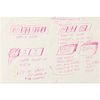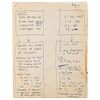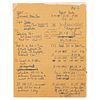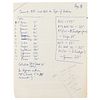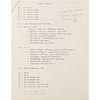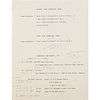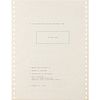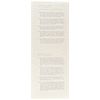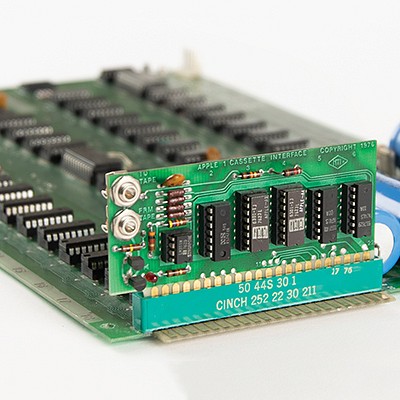Steve Jobs Hand-Annotated Atari Horoscope Program Archive
Two ways to bid:
- Leave a max absentee bid and the platform will bid on your behalf up to your maximum bid during the live auction.
- Bid live during the auction and your bids will be submitted real-time to the auctioneer.
Bid Increments
| Price | Bid Increment |
|---|---|
| $0 | $5 |
| $50 | $10 |
| $200 | $25 |
| $500 | $50 |
About Auction
Aug 24, 2023
RR Auction support@rrauction.com
- Lot Description
Historic archive pertaining to the development of "Astrochart," an astrology/horoscope application that Steve Jobs was working on for Atari in the summer of 1975, one year prior to founding Apple Computer. The archive comprises a handwritten/hand-sketched design by Jobs for a user interface; an eight-page manuscript in another hand that provides a conceptual flow chart for the program, with a few handwritten notations by Jobs throughout; two typed reports prepared by Jobs for Stephen Bristow pertaining to the derivation/computation of planetary coordinates and astrological times; a horoscope printout for Steve Jobs; and several pages of code and program printouts.
The highlight of the archive is ostensibly Jobs's hand-sketched design for Astrochart's user interface, accomplished in red ballpoint on a 6 x 4 sheet. Evidently conceived in the vein of an arcade cabinet, the user would input date of birth, time of birth, and place of birth using physical buttons or switches—above the time display, Jobs ponders, "thumbwheel from 1-12?"—and would then receive their horoscope by pushing a "Ready" button. He also envisions a "Famous People" button, which might bring up a list to choose from—a playful addition meant to capitalize on society's fascination with celebrities. Most significantly, this piece demonstrates Steve Jobs's natural talent for creating simplified, user-friendly interfaces between humans and computers.
Further, this archive reveals Jobs's technical skill as he works through the complicated derivation of planetary coordinates and the challenges of developing an efficient software program. In the flow chart for the application, a programmer has described in detail the steps and methods for calculating the user's zodiac symbol. Jobs makes several small notes and corrections throughout. For example, in a section about data input, Jobs writes: "Since only integer desired: sub 15 and increment register. No divide needed." For calculating midheaven, Jobs notes: "Convert radians to minutes X(244080/71)." On the last page, he sketches a table of calendar and zodiac sign values necessary for such computations.
The papers prepared by Jobs for Stephen Bristow, his supervisor at Atari, include a ten-page report entitled "Where are the stars?" and an eight-page report entitled "Because it is." In the first, Jobs defines Astrochart's final equations for calculating planetary coordinates. He makes a few handwritten notations throughout. On a page of equations, Jobs writes: "If planetary parameters are given in degrees—use conversion 71/4068." He makes several additional notes on the last page, modifying the "Final Moon Correction Terms" and "Subroutine Arc Tangent." The second paper concerns "the calculation of GMT, Sidereal Time, Ascendant, Midheaven and Absolute Day," and has no handwritten notations. Both are marked "All-One Farm Design" on the cover sheets, a name Jobs appropriated from the commune he frequented at the time.
Also noteworthy is the eight-page dot-matrix printout of Jobs's horoscope from Call Computer in Mountain View, California, dated August 23, 1975, headed: "This horoscope has been prepared for Steven Jobs." Using his birth date of February 24, 1955, the 20-year-old Steve Jobs receives his horoscope with interpretations of his natal planetary positions and aspects. Several of these interpretations—making note of "creativity in routine matters," "desire for growth," and "eccentricity or unorthodox response"—offer fascinating insight when considered within the context of Steve Jobs's life and career. The document notes that it was "Computed on a BASIC Time-Sharing 3000 Computer." The archive also includes about 25 pages of computer program and code printouts, one annotated by Jobs with definitions for parameters "r1" through "r6." In overall fine condition.
In 1974, Jobs was perusing the tech industry's help-wanted classifieds in the San Jose Mercury when an Atari headline caught his eye: 'Have fun, make money.' When the unkempt teen showed up in Atari's office—and refused to leave until they gave him a job—the personnel manager didn't know whether to let him in or call the cops. Knowing that the dropout youngster would be cheap to hire, Atari's chief engineer—Pong creator Allan Alcorn—said: 'Send him in!' Since Jobs knew how to solder and wire wrap, he was hired on as a technician.
At Atari, Jobs learned to keep user interfaces simple and intuitive—after all, the company's success was rooted in Pong's simplicity: 'Deposit Quarter, Avoid Missing Ball for High Score.' This sort of elegant user-friendliness would become a hallmark of Jobs's later products—from the one-button mouse to the touchscreen iPhone. He also refined his business acumen—Jobs famously farmed out the engineering of the Atari 'Breakout' prototype to his friend, Steve Wozniak, who implemented several innovative cost-savings circuit designs. Jobs earned a $5000 bonus for the project’s success and reportedly kept it a secret.
In this archive, Jobs provides some "Astrochart" equations and concepts to his supervisor, Stephen Bristow—the video game pioneer who helped develop the design concept of Breakout, and assigned Jobs to that project. In an interview with retrogamer.net, Bristow recalled: 'Steve Jobs always had an appreciation of his own ability. He wasn’t allowed onto the production floor because he wouldn’t wear shoes, only sandals. There was a special-ness to him.' - Shipping Info
-
Bidder is liable for shipping and handling and providing accurate information as to shipping or delivery locations and arranging for such. RR Auction is unable to combine purchases from other auctions or affiliates into one package for shipping purposes. Lots won will be shipped in a commercially reasonable time after payment in good funds for the merchandise and the shipping fees are received or credit extended, except when third-party shipment occurs. Bidder agrees that service and handling charges related to shipping items which are not pre-paid may be charged to a credit card on file with RR Auction. Successful international Bidders shall provide written shipping instructions, including specified Customs declarations, to RR Auction for any lots to be delivered outside of the United States. NOTE: Declaration value shall be the item’(s) hammer price and RR Auction shall use the correct harmonized code for the lot. Domestic Bidders on lots designated for third-party shipment must designate the common carrier, accept risk of loss, and prepay shipping costs.
-
- Buyer's Premium



 EUR
EUR CAD
CAD AUD
AUD GBP
GBP MXN
MXN HKD
HKD CNY
CNY MYR
MYR SEK
SEK SGD
SGD CHF
CHF THB
THB
